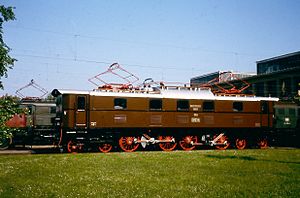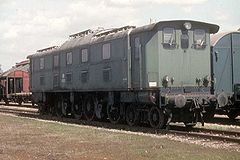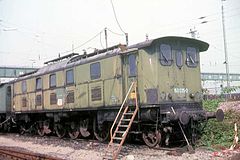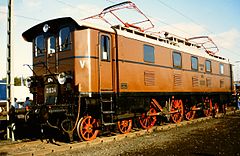DR series E 52
| EP 5 DR series E 52 DB series 152 |
|
|---|---|
|
E 52 34 (EP 5 21534)
Exhibition 100 years of electric railways |
|
| Numbering: | EP 5 21 501-535 DR E 52 01-35 DB 152 001-035 |
| Number: | 35 |
| Manufacturer: | WASSEG , Maffei |
| Year of construction (s): | 1924-1925 |
| Retirement: | 1973 |
| Axis formula : | 2'B B2 ' |
| Gauge : | 1435 mm ( standard gauge ) |
| Length over buffers: | 17,210 mm |
| Height: | 4,810 mm |
| Coupled axle wheel base: | 2,650 mm |
| Total wheelbase: | 13,600 mm |
| Smallest bef. Radius: | 180 m |
| Service mass: | 140.0 t |
| Wheel set mass : | 19.6 t |
| Top speed: | 90 km / h |
| Hourly output : | 2,200 kW |
| Continuous output : | 1,660 kW |
| Starting tractive effort: | 196 kN |
| Performance indicator: | 15.7 kW / t |
| Driving wheel diameter: | 1,400 mm |
| Impeller diameter: | 850 mm |
| Power system : | 15 kV 16 Hz ~ |
| Power transmission: | Overhead line |
| Number of traction motors: | 4th |
| Drive: | Rod drive |
| Brake: | Air brake |
| Train control : | Sifa |
The EP 5 series (from 1927: E 52 series , from 1968: 152 series ) was an electric locomotive for heavy passenger traffic of the German State Railroad (DR) and the German Federal Railroad (DB).
history
The first procurement program for new vehicles set up by the Deutsche Reichsbahn Gruppenverwaltung Bayern also included an electric locomotive for heavy passenger train service on the electrified routes in Bavaria . From numerous drafts, a decision was made in favor of a 2'BB2 'locomotive, which was to have the same engines as the class E 91 freight locomotive that was also planned .
With this new design, the previous design of electric locomotives with a large, slow-running engine was abandoned and the decision was made to use four smaller electric motors . The engine was arranged in two groups in a continuous frame. Each group has two motors that drive a common countershaft via gear wheels. This drives a jackshaft via oblique connecting rods, which is coupled to two drive axles by coupling rods. In order not to exceed the permissible axle loads, the machines were each given a two-axle leading and trailing bogie. Three of the four drive axles are laterally movable. The locomotive body with the two end driver's cabs is built on the frame . On the front walls there were front wall doors with transition sheets, which were later removed. The superstructure was originally painted brown, the chassis was black, the wheels were red. The pantograph was of type SBS 9.
The vehicle part was manufactured by Maffei and the electrical equipment by WASSEG, a joint venture between AEG and SSW .
The manufacturers delivered the locomotives in 1924 and 1925 to the Bavarian group administration of the DR, which took them into operation as class EP 5 with the numbers 21 501-535. In 1927 they were given the designation E 52 01-35. The vehicles were located exclusively at Bavarian deployment sites. By 1945 the E 52 02, 31 and 35 were retired due to the war.
DB class 152
The DB took over the remaining machines, and the war-damaged E 52 01, 29 and 32 were retired by 1950. The remaining 29 machines were given the designation class 152 in 1968. However, when new, powerful electric locomotives became available in sufficient numbers as a result of the new building program of the DB , these heavy machines quickly became dispensable. In the 1960s the series was u. a. when Bw Nürnberg central station located in the passenger train and between Nuremberg and Treuchtlingen used.
From 1966, the remaining machines were brought together at the Kaiserslautern depot, which then became a discontinued depot. The locomotives were mainly used in freight train traffic between Kaiserslautern, Neustadt (Wstr.) And Ludwigshafen (- Mannheim). In the last few years of operation, pre-tensioning and pushing services for diversions were also on the agenda as part of the electrification of the Moselle route. In addition, there is graphic evidence of passenger and relief train services on the Mannheim – Saarbrücken railway line .
As early as February 1973, 152 014, the last machine of this series, was retired from the Kaiserslautern depot.
At 140 tons, the E 52 was the heaviest electric locomotive that ever ran in Germany, not the DR series E 95 , as is often claimed.
The class number 152 was used again in 1996 by Deutsche Bahn AG for a new type of locomotive, see DB class 152 .
Whereabouts
First, several 152, stripped of their connecting rods, were used as transformer locomotives . These missions ended in the mid-1980s.
Of the 35 E 52 series locomotives that were built, only one machine remained. The E 52 34 is today, labeled as EP 5 21534, inoperable in the possession of the DB Museum Nuremberg and has been on display again in Vehicle Hall II of the DB Museum Nuremberg since May 2014.
DB 152 022, previously a heating locomotive in Lörrach, was in Offenburg long after it was retired (1985). Apart from the museum locomotive, it was the last remaining E 52.
Web links
- E 52 05 1958 in Bad Cannstatt on the Joachim Schmidt Railway Foundation
literature
- Harald Schönfeld: Germany's heaviest . In: Eisenbahn Magazin . No. 6 , 2016, p. 6-11 .
- Horst J. Obermayer: Paperback German electric locomotives. 7th edition, Franckh'sche Verlagshandlung, Stuttgart 1986, ISBN 3-440-03754-1 .
- Ulrich Schwanck: About the running characteristics of the electric 2'BB2 'locomotive, class E 52, of the Deutsche Reichsbahn. In: Lok Magazin . Issue 89, March / April 1978, pp. 100-107.
Individual evidence
- ^ The course book section 670 - Chronicle - 1966 to 1975. Retrieved on August 18, 2017 .
- ↑ Turntable Online Forums :: 04 - Historic Railway :: Two questions about the E 52 in the Kaiserslautern depot. Retrieved August 18, 2017 .
- ^ Railway Foundation : 152 014 in the pre-stressing service between Neustadt and Kaiserslautern. Railway Foundation, accessed August 18, 2017 .
- ^ Railway Foundation : 152 004 with relief train in Kaiserslautern. Retrieved August 18, 2017 .
- ↑ Re:? [D] Old-style electric locomotives at the end of the 1960s far from home. In: Drehscheibe-Online. Arbeitsgemeinschaft DREHSCHEIBE eV, January 9, 2014, accessed on August 18, 2017 (online forum).



